The Nai Soi camp, deep in the Thai jungle, is home to 15,000 Burmese refugees, many of whom will never leave. When actor and supermodel Lily Cole visited, she found a thriving community determined to make the most of a difficult and dangerous political situation
Day one
London to Mae Hong Son, Thailand
I'm lying in bed, drums playing outside, along with the singing of crickets, the frogs and the fireworks.
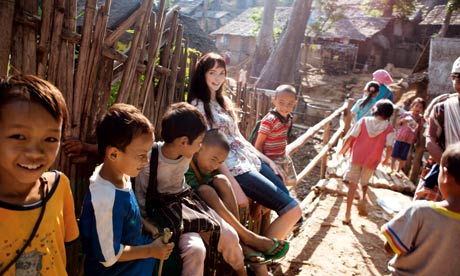 |
| "I am struck by the intricacy of this little world": Lily Cole at the Nai Soi camp for Burmese refugees. Photograph: Kate Tomlinson for the Observer |
Day one
I'm lying in bed, drums playing outside, along with the singing of crickets, the frogs and the fireworks. We arrived late this afternoon to this beautiful little town in northern Thailand. Two days, four airports, three planes: it's surreal and I feel dislocated from my purpose – have I taken a week off to go backpacking? Not quite. I am only the second "public figure" to be invited here to visit the Nai Soi refugee camp, where Christian Aid is keen to raise awareness of what they call the forgotten crisis.
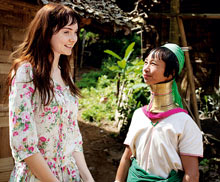 |
| Lily talks to a traditionally dressed "long-necked" Karenni woman. Photograph: Kate Tomlinson for the Observer |
We arrived late this afternoon to this beautiful little town in northern Thailand. Two days, four airports, three planes: it's surreal and I feel dislocated from my purpose – have I taken a week off to go backpacking? Not quite. I am only the second "public figure" to be invited here to visit the Nai Soi refugee camp, where Christian Aid is keen to raise awareness of what they call the forgotten crisis.
Day two
Nai Soi camp in Ban Mai
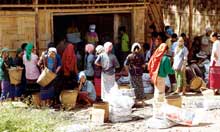 |
| The camp's food distribution centre. Photograph: Kate Tomlinson for the Observer |
We pick up our camp passes, which the Thai authorities had to approve and issue. The refugee camps were set up as an ad hoc solution in 1984, on land loaned by the royal Thai government three miles from the border, when thousands of Burmese fled from the military regime and ethnic conflict in Burma. Despite not being signatories to the UN convention on refugees, Thailand has played host to thousands of Burmese refugees. It was never expected that the camps would still exist 26 years later.
Thai police and military patrol the area outside the camp. Inside we meet the camp committee, made up of refugees who are democratically elected, which takes care of the logistics for the 15,000 refugees who live here. The government treats the refugee camps as a temporary solution to the situation in Burma and so has denied any infrastructure or designs of permanence within the camps, such as concrete buildings, phone lines, electricity (there are a few generators) or internet access.
Yet within such a temporary environment, the community has developed a web of structures and services that resemble a small state. I am struck by the intricacy and organisation of this little world unto itself, which has its own internal NGOs, schools, clinics, a Buddhist temple, a church, an animist shrine, its own legal system and even a detention centre to hold those committing petty crimes.
Many of the refugees fear death or imprisonment were they to return to Burma under its current political situation. No government is responsible for them, and they haven't the land, resources or the rights to sustain their own lives. So they are dependent on the aid of international NGOs such as Christian Aid.
I visit a Karenni nursery school, where a class of around 90 five-year-olds, lined up like sleeping lions, is gazing up at me, a stranger interrupting their napping hour. The school teaches English, maths and science, as well as the children's native language.
Most of the 145,000 who make up the population of the nine camps along the Thai-Burmese border are from ethnic minorities in the east of Burma. The Karenni are from the Karenni state of Burma and have a distinct cultural identity, language and religious belief that they are not allowed to practise freely. They have been fighting the Burmese military regime for independence or a federal government since 1950.
After the nursery, I visit the Phumawsheleh weaving centre, running since 2002. The weavers are making sarongs which, every two years, are distributed among the refugees. They are paid the equivalent of 50p for each sarong they make. Next year it's the men's turn. It is one of the projects that tries to make the refugees more self-sufficient – they are encouraged to grow vegetables between their bamboo shelters, although the lack of space, the hilly landscape and the limited water supply in the dry season prohibit any significant production.
I meet Su Meh, who weaves traditional clothes at her home using handmade equipment. When I ask why she is in the camp, her gaze falls. She tells me that she fled Burma 14 years ago, when the military set fire to her village. The villagers – 70 households in all – escaped and lived in the jungle for three months before finally managing to cross over to Thailand. Several died before they made it to the refugee camp. Su Meh says it is painful to think about her past and she just wants to think about her future. Holding her young daughter, one of her three children, she emphasises the precious feeling of safety she feels here. Safety: a seemingly abstract and simple resource, but when compared to food, shelter or medical care, it is perhaps the biggest gift these camps provide.
Lastly I visit Kae Mgni, whose family has been in the camp since 1983. Kae Mgni is the chief judge and has just received authorisation for his family's resettlement in Australia. He doesn't know where in Australia he's going or what job he will get, but because it is a democracy, he says cheerfully, anything will be good. His teenage daughter, who has spent her whole life in the camp, breaks into a big smile. I ask what he will miss most and he says the community, the big family they are part of here.
With Kae Mgni's happy story in mind I leave the camp for the day, before the sun sets. Out in the open, beautiful expanse of Thai forest, where rice fields roll into mountainous vistas, I realise how claustrophobic the camp had felt, and how sad it is that the refugees cannot explore this space.
Day three
Nai Soi camp in Ban Mai
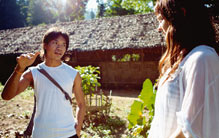
We drive into the camp past an animist shrine with an animal skull resting on top, a site of sacrifice. The planks of wood mark an eerie cross against the misty early-morning backdrop of jungle foliage.
The camp's food distribution centre. Photograph: Kate Tomlinson for the Observer
The first family we meet are Taw Reh and his wife Neh Meh, who arrived with their six children in July. They left Burma because Taw Reh, forced to work for the military regime, was being kept under house arrest for 43 days as a way of instilling fear.
At the food-distribution centre, refugees come to collect their monthly rations: rice, beans, salt, sugar, chilli, oil, a nutritional supplement called AsiaMix, and charcoal. The atmosphere is friendly and cheerful. There are several Karenni women dressed in traditional clothes, their necks circled by coloured beaded necklaces, their ear lobes gaping wide and low under the weight of silver earrings, metal wrapped around their calves like bracelets. I'm inspired by these dignified, beautiful women, laughing and helping one another pile charcoal into baskets on their backs.
After lunch we move on to the Karenni Post-10 School where I meet the older students. Being around the same age, I'm moved by the enforced limits of their aspirations. My translator, 17-year-old Khinpwondlay, tells me she wants to pursue higher education, but asks, defeated, what's the point of studying if she can't go anywhere with it.
Kyaw Zin, 22, lost his refugee status and may now have to stay in the camp for life. Photograph: Kate Tomlinson for the Observer
I wander around the back of the bamboo-hut classroom, library and computer room, with its few donated laptops but no internet. A student comes round the corner, eager to talk. Twenty-two year old Kyaw Zin has been in the camps since he was 15. He was walking in the jungle with a friend in eastern Burma when he was captured by the military, who forced him to be a porter for them, unpaid. It's a common tactic.
After several days he escaped to the jungle, where he lived as an internally displaced person (IDP). A family took pity on him and became his "adopted" parents. Together they fled to the refugee camps a few months later. Here he received his official UN refugee status and spent four months doing medical training and four months working in the camp clinic. Having seen so much suffering in eastern Burma, he returned there, hiding in the jungle to try and help people dying of malaria and diarrhoea in the villages (Burma spends 0.2% of its GDP on healthcare, compared to 30% on the military). I couldn't help comparing him to most other 22-year-old boys I know.
A year later he returned to the camp to find that because he had disappeared he had lost his official UN refugee status, which means he now has no possibility of being resettled. If the political situation doesn't change in Burma, Kyaw Zin could spend his life within the square mile of the camp, caught between politics and bureaucracy. When I ask if he will get another chance to get a UN number he kicks at the dry earth, looks down and says, seemingly without bitterness: "No, you only get one interview."
His adopted family has since resettled in America. When I ask if he feels angry towards the Burmese regime, he says: "No, I don't hate them – I just don't like their policies." As I leave the camp later on, Kyaw Zin is playing tennis with a friend on a concrete court that the head teacher broke Thai sanctions to put down (concrete being considered too permanent). A little boy in orange, his head shaved like a monk, smiles as he pulls a kite across the air, and the sound of students singing, practising for a church competition, floats out of the bamboo assembly hall. It is a powerful image: young adults with a sense of community and purpose, in spite of extraordinary stories of hardship around them, playing together.
Day four
Nai Soi camp in Ban Mai
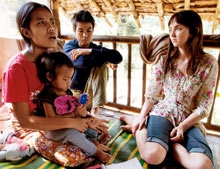 Kay Roh and his wife Rhaimae have been in the camp for a year. Photograph: Kate Tomlinson for the Observer
Final day in the camp. We meet Kay Roh and his wife Rhaimae, who arrived a year ago. Rhaimae does most of the talking, while Kay Roh hangs his head. He has recently become very ill, she says, and they are hoping it isn't malaria. For the last year she has made an income for the family by working for the Karenni National Women's Organization, but he is unable to work, as he is "uneducated". Having worked as a farmer in Burma, and with no adult education programmes available in the camp, it is impossible for him to secure one of the limited opportunities for work within the camp. They use the word "uneducated" with a sort of shame that makes me feel terrible. Here is a skilled man who simply can't put those skills to use in this new setting.
After lunch I am sitting on a bridge running over a river when there's a sudden magical moment. Dozens of children appear, giggling, swarming, like the butterflies and the dragonflies that grace all corners of the camp, colourful and beautiful. Light spills down the steep valley of trees, huts and people. Surrounded by darkness, this community of the land's orphans has built a home bursting with light. Once again I remember how fragile this simple oasis is; structurally transient and suspended in time, as ephemeral as dragonflies' wings. Without the compassion of people around the world, these camps wouldn't exist. When I ask a teenager born in the camp his dreams for the future, he replies: "To be a citizen." "Of where? Burma, Thailand, elsewhere?" I ask. "Anywhere," he says, smiling, imagining the day.
In the afternoon we go and visit a family which has set up a shop on the main square selling, bizarrely, electronics, noodles and beauty products. They sell mobile phones as music players. They have a makeshift green screen in the back of the shop to take digital photographs against, and an assortment of backdrops from parks to beaches. I take a photo of Khinpwondlay and ask which backdrop she wants. "A beach," she says. Has she ever seen a beach? "No," she replies. Of course she hasn't.
The last thing we do before leaving is streak Thanaka powder across my cheeks in the way I've seen many of the refugees – women, children and men – do over the past few days as a natural sunscreen, and go to the animist shrine. Fifteen or so carved wooden poles stand eerie and erect in a cleared space. There is something powerful and sacred in their simplicity; analogous to the impression I have had of the camp at large. I offer thanks and a prayer for the refugees. We run into the playground where the kids have been pushing their noses against the bamboo gates to watch us.
The sun is sinking low, enriching the playground in the beautiful red haze of dusk, and we are being motioned out of the camp before nightfall. A boy pushes his friend forward on a bike, a girl runs, streaking a kite across the horizon. We push for an extra minute or two with these playful spirits. As we drive away I want to film everything I see. Everything is inspiring. We close the gates.
Christian Aid's Christmas Appeal highlights the plight of tens of millions of refugees worldwide driven from their homes by disaster, war, persecution or hunger. Donations can be made by calling 0845 7000 300 or at christianaid.org.uk/christmas
Model and actor Lily Cole appears in Roland Joffé's There be Dragons, released next spring
Kay Roh and his wife Rhaimae have been in the camp for a year. Photograph: Kate Tomlinson for the Observer
Final day in the camp. We meet Kay Roh and his wife Rhaimae, who arrived a year ago. Rhaimae does most of the talking, while Kay Roh hangs his head. He has recently become very ill, she says, and they are hoping it isn't malaria. For the last year she has made an income for the family by working for the Karenni National Women's Organization, but he is unable to work, as he is "uneducated". Having worked as a farmer in Burma, and with no adult education programmes available in the camp, it is impossible for him to secure one of the limited opportunities for work within the camp. They use the word "uneducated" with a sort of shame that makes me feel terrible. Here is a skilled man who simply can't put those skills to use in this new setting.
After lunch I am sitting on a bridge running over a river when there's a sudden magical moment. Dozens of children appear, giggling, swarming, like the butterflies and the dragonflies that grace all corners of the camp, colourful and beautiful. Light spills down the steep valley of trees, huts and people. Surrounded by darkness, this community of the land's orphans has built a home bursting with light. Once again I remember how fragile this simple oasis is; structurally transient and suspended in time, as ephemeral as dragonflies' wings. Without the compassion of people around the world, these camps wouldn't exist. When I ask a teenager born in the camp his dreams for the future, he replies: "To be a citizen." "Of where? Burma, Thailand, elsewhere?" I ask. "Anywhere," he says, smiling, imagining the day.
In the afternoon we go and visit a family which has set up a shop on the main square selling, bizarrely, electronics, noodles and beauty products. They sell mobile phones as music players. They have a makeshift green screen in the back of the shop to take digital photographs against, and an assortment of backdrops from parks to beaches. I take a photo of Khinpwondlay and ask which backdrop she wants. "A beach," she says. Has she ever seen a beach? "No," she replies. Of course she hasn't.
The last thing we do before leaving is streak Thanaka powder across my cheeks in the way I've seen many of the refugees – women, children and men – do over the past few days as a natural sunscreen, and go to the animist shrine. Fifteen or so carved wooden poles stand eerie and erect in a cleared space. There is something powerful and sacred in their simplicity; analogous to the impression I have had of the camp at large. I offer thanks and a prayer for the refugees. We run into the playground where the kids have been pushing their noses against the bamboo gates to watch us.
The sun is sinking low, enriching the playground in the beautiful red haze of dusk, and we are being motioned out of the camp before nightfall. A boy pushes his friend forward on a bike, a girl runs, streaking a kite across the horizon. We push for an extra minute or two with these playful spirits. As we drive away I want to film everything I see. Everything is inspiring. We close the gates.
Christian Aid's Christmas Appeal highlights the plight of tens of millions of refugees worldwide driven from their homes by disaster, war, persecution or hunger. Donations can be made by calling 0845 7000 300 or at christianaid.org.uk/christmas
Model and actor Lily Cole appears in Roland Joffé's There be Dragons, released next spring
No comments:
Post a Comment